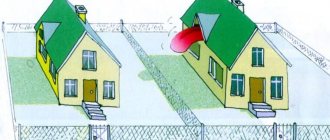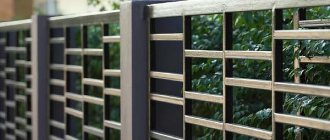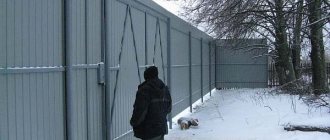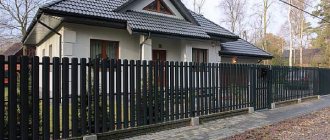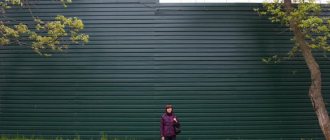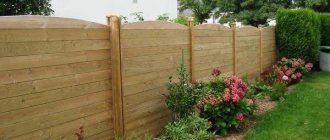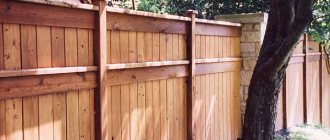Each owner wants to delineate the boundaries of his plot from the neighboring estate, street, roadway. A fence is responsible for this function - a structure that protects the territory from excess noise, prying eyes and harmoniously complements the yard.
But before starting work, it is important to find out and follow a number of rules that indicate the permissible height of the fence, so that in the future the structure does not cause quarrels with neighbors.
We recommend that you familiarize yourself with our other materials:
- At what distance from the fence can you build a house?
- At what distance should trees be planted from neighbors’ fences?
What standards regulate the size of fences?
To be sure that the installation of a fence between areas is carried out without violating the current legislation, it is worth studying at least two sources of reliable information:
- Construction norms and rules of the Russian Federation (SNiP) 30-02-97.
- Regulatory recommendations developed by the regional municipality. These can be obtained from your local architectural department.
The documents should be carefully studied before the design of the structure begins. This way you can avoid violations of the law even before the start of construction, and eliminate the risk of moving or dismantling the finished structure.
Where to complain
If a fence is being erected or has already been erected between areas that violates legal norms, the citizen whose rights have been infringed may complain. This should be done after the issue has not been resolved peacefully. In this case, you need to go to court.
The following documents must be attached to the statement of claim:
- land title document;
- cadastral plan;
- land survey plan;
- diagram of both sections;
- other documents requested by the court.
The court's decision depends only on the evidence presented, so such a step can only be taken if the plaintiff is completely confident that he is right and can confirm it with documents.
This is interesting: Legalization of unauthorized buildings in Moscow
SNiP recommendations for fence construction
The document states the following:
- The average height of the fence is up to 1.5 m (in some regions it is allowed to install up to 2.2 m).
- Blind fences that do not transmit light are allowed to be installed only on the street side to protect from the roadway or in special-purpose institutions.
- It is prohibited to build a fence directly on the border of two estates. The construction is carried out 0.5 m towards its territory.
- The light transmittance of the structure must be at least 50%.
But it is important to remember that in each region of the country the optimal fence height varies. If in the Moscow region the value is 1.5 m, then in the Volgograd region the maximum permissible is 2.2 m (provided that 0.75 m of the fence is blank, and the rest allows light to pass through well).
If you need to make a fence higher than 2 m in the private sector, in a country house or in a cottage community, you should obtain permission in advance from specialists in architectural services.
Features of legislation
In 2021, changes were made to sanitary and building standards, according to which the fence between two areas should not be higher than one and a half meters in height. In addition, it must be done from a chain-link mesh. However, if you achieve agreement with your neighbor, then it is quite possible to build a higher fence, as well as build it from a different material.
That is, you can’t install solid fences, but if your neighbor doesn’t mind, then you can. Thus, all the rules established regarding fences between neighbors can be circumvented. Also, the legislation does not regulate the height of a fence facing a road or ravine. In this case, the owner of the site has the right to erect any fence, regardless of the type of material used and height.
Height limits depending on material
It is important to remember that the height of the fence is directly proportional to the length of the estate. Therefore, you should not build high walls around a small summer cottage.
In addition, the growth rate of plants and trees planted near the fence depends on the transparency of the structure.
Let's look at recommendations regarding the height of a fence between neighbors made from different materials.
Chainlink
Metal grid. Produced in rolls 10 m long and 1.5 m wide. You can individually order a chain link of greater length.
Read the article: “How to build a chain-link fence”
An excellent option for delineating the boundaries of a summer cottage. It allows light and air to pass through well and will not be an obstacle to normal plant growth.
There are no special height restrictions. Recommended for installation around fruit plantings and front gardens.
Corrugated sheet
The optimal height is 1.5–2 m. But the larger the area of the fence, the more the load on the foundation will increase.
Article to read: “Wood-like corrugated sheet fencing”
For houses with a large territory, it is worth taking a metal profile as pillars, and a monolithic strip for the foundation.
Profiled sheets do not allow light or air to pass through, so when installing on the border with a neighboring property, it is better to obtain the consent of its owners in advance.
Brick, concrete
Fences made of solid materials should be installed on the street side. If you decide to put a reliable brick fence around the entire house, then you need to build it at a distance of 1 m towards your estate.
The optimal height is 1.5–2 m (the exact figure depends on the region). A larger figure is allowed for fencing construction sites.
A solid fence does not allow light or air to pass through. Therefore, planting low-growing plants nearby is unacceptable.
Article on the topic: “How to make a brick fence”
Combining stone, brick or concrete panels with other materials is another matter.
Brick pillars with a base look beautiful in combination with forged or polycarbonate spans.
Prefabricated concrete panels called Eurofence are inexpensive. They do not need finishing and provide the necessary air exchange and access of light to the territory. If you wish, you can order the installation of such a turnkey structure from any construction company.
Euro picket fence
The recommended height is 1.8 m. This is a good option for both street and fencing between areas. Material – metal. The shape resembles a standard wooden picket fence. It is attached with gaps, thereby ensuring good passage of air and light. Installation is simple, so you can do it yourself.
When looking for a budget material for fencing a private property, preference should be given to mesh. If you want a reliable and beautiful structure, then prefabricated concrete panels or a European picket fence are best suited.
Users often search for:
- Construction of a wooden picket fence
- Metal picket fence
Fence height standards according to SNiP 2018–2019
Depending on where the fence is installed, the recommended indicators may differ significantly. Let's look at the requirements for popular forms of ownership.
TSN (SNT, DNP, ONT, LPH)
Referring to the Land Code of the Russian Federation, Federal Law No. 217-FZ dated July 29, 2017, plots are classified according to their intended purpose and type of use.
We recommend that you read: “Installing a wooden fence with brick pillars”
Agricultural lands include:
- ONT – gardening non-profit partnership;
- SNT - gardening non-profit partnership;
- DNP – dacha non-profit partnership;
- Private subsidiary plot – personal subsidiary plot (category – field plots).
According to Federal Law No. 217-FZ dated July 29, 2017, which came into force on January 1, 2019, partnerships ONT, SNT, DNT, private household plots (category - field plots) acquire a new form TSN - Real Estate Owners Partnership with a single charter.
However, the requirements regarding the height of the fence according to the law for TSN in the new SNiP are advisory.
Among other documents regulating the size of fences for TSN:
- SP 53.13330.2011;
- Order of the Ministry of Regional Development of the Russian Federation dated December 30, 2010 No. 849;
- SNiP 30-02-97 Town Planning Code of the Russian Federation.
In accordance with SP 53.13330.2011, the height of the fence between TSN lands should not be more than 1.5 m, on the street side - a maximum of 2.2 m.
Other recommendations:
- It is prohibited to install blind fences that will create a shadow on the neighbors’ estate.
- The optimal fence material is mesh, welded gratings, picket fence.
- The gate and the gate open into the yard at a distance of 1.5 m from the street sidewalk, so as not to impede the movement of passers-by.
- If the fence is a hedge, then with the consent of the neighbors its height should not exceed 1.5 m.
- If the thickness of the structure is more than 5 cm, the fence is installed so that it does not cross the boundaries of your site.
It is allowed to install a blind fence on the street side or roadway without anyone’s consent.
The construction of a continuous fence on the border of estates is possible by decision of TSN members and with the participation of neighbors.
Individual housing construction, private household plots (category – personal plots)
Now the construction of fences of any type in individual housing construction (IHC), personal subsidiary plots (LPH) is not limited by current legislation.
Photo: fencing height indicator – 1,830 mm
Private household plots should be understood as the category of personal plots.
Recommended design parameters are described in the Land Use and Development Rules, which are controlled by the administration of the municipality of a particular locality.
That is, the height of fences is regulated at the level of local authorities. To avoid breaking the law, it is better to submit a request before starting work asking for clarification of the requirements for fences in your region.
Private sector, village
There are no legal regulations. The situation is similar to individual housing construction. Regulation is carried out by the administration of the municipality.
If it is not possible to submit a written request to local authorities or there are no recommendations in this regard, then it is necessary to document the start of construction, save receipts for the purchase of materials, and obtain written consent from neighbors.
Yard fences
Norms that would regulate the installation of structures inside one estate in a city or smaller settlements have not yet been developed.
Photo: fencing the courtyard area with a wooden picket fence
The main function of such structures is zoning the territory. Both tall transparent structures (made of mesh) up to 2 m, and low decorative ones – up to 0.5 m (made of stone, wood) are allowed for installation.
Examples of fences for installation on individual housing construction and TSN lands
What kind of fence is suitable for erecting around a cottage or private house? In fact, almost anyone. Usually, when it comes to installing fencing in a city or town, owners rely on several requirements:
- protection of territory, property, life and health of household members;
- aesthetics - harmony with the rest of the home’s design;
- good value for money;
- long service life.
By erecting a fence around a private house, the owners expect that it will stand for a long time, protect the site and please the eye, and that it will not have to be regularly repaired or completely dismantled in a few years. Modern materials and technologies make it possible to build a fence that will meet all requirements.
Instructions for installing high fencing according to the law
When relations with neighbors are tense, the owners want isolation, and a high fence helps with this. Such a design is necessary when the house is located at the end or on the corner of the street in order to protect the estate from intruders.
Photo: fencing the site with a wooden fence over 2,000 mm.
In order not to formally break the law, during construction you should adhere to the following sequence of actions:
- Record the boundaries of your territory in the BTI.
- Place delimiters in the form of pegs and a stretched rope at the boundaries of the plots. Take a video, take a photo.
- Install a low translucent fence up to 1.5 m, following the recommendations of SNiP. Record what is happening step by step on video.
- When taking photos, use a construction surveyor's ruler. It clearly shows compliance with the required distances.
- Insure the erected structure.
- Make a 1 m indent from the small fence. Start building a permanent fence of the required height. Record everything again in photos and videos.
- Collect receipts, invoices for paperwork and purchase of materials in a separate folder.
A decorative fence must be made so that neighbors do not have the opportunity to move the boundaries of the site to the main structure. Otherwise, they will be able to make claims against the fence in court.
What to do if your neighbors have installed a high fence
When, with the appearance of a blank fence on the part of neighbors, the normal life of the residents of the site is disrupted, then you can defend your rights like this:
- The owners of TSN lands must submit a written complaint about violation of the partnership charter.
- Additionally, file a claim in court for a violation under Article 304 of the Civil Code of the Russian Federation “Protection of the rights of the owner from violations not related to deprivation of property.”
It is necessary to provide evidence of how the constructed fence causes harm. If it creates shading of the area, which leads to a decrease in yield and rotting of plants, then you need to take photos before and after installing the fence.
The result of a court decision depends on the quantity and quality of the evidence base.
You should not rely on SNiP, since the standards are advisory in nature and will be ineffective during legal proceedings.
How disputes are resolved
Disputes and disagreements between neighbors over fences arise quite often. Often this happens because of the marking line, since one of the neighbors may not agree with it. You can also often encounter disputes over the installation of a blind fence - such a fence limits the ventilation and lighting of the site, and this already reduces the usable area of the land.
The issue can be resolved in several ways:
- negotiate with neighbors;
- contact the administration;
- file a lawsuit.
In the last two cases, you should be completely confident that you are right in order to initiate proceedings at the legal level.
To avoid conflict with neighbors and going to court, you should pay attention to several recommendations:
| Coordinate with neighbors | They cannot be presented with a fait accompli before the work begins. If you need to change the fence from the street, then there is no need to do this. |
| Invite a surveyor and determine the boundaries of the site | This will help solve many issues related to the correct construction of the fence in exactly the right place. |
| Plan the height and material of the fence with your neighbors | This is especially important for the construction of a blind fence, since in this case their permission will be required. |
| If you cannot reach a peaceful agreement with your neighbors, you can file a lawsuit | During the trial, the judge may not only allow the construction of a fence, but also oblige neighbors to participate financially in its construction. |
It is important to be understanding of other people's opinions. If all wishes are taken into account before the fence is erected, then no conflicts will arise afterwards.
Height requirements for gates and posts
When selecting the height of the supports, it is important to remember that they are buried in the soil lower than the freezing point of the soil. The average is 1.2–1.5 m, but it differs depending on the material:
- For a chain-link, a depth of 0.5 m is sufficient with an above-ground height of 1.2 m.
- For corrugated sheeting, the total height is 3 m. The above-ground part is 1.8 m.
- When creating brick and concrete fences, it is worth considering the thickness of the masonry. When the height of the structure is 3 m, the masonry is laid with 2 bricks, up to 3 m - with 1.5 bricks.
The gate must be flush with the sections. Any deviations in height will give an unsightly appearance to the entire structure.
The more massive the gate, the greater the load it puts on the foundation, so it is important to think about the type of foundation in advance.
If you want to highlight a gate with a wicket against the general background, then it would be right to decorate it with artistic forging.
Disputes between neighbors
If misunderstandings arise with the owners of a neighboring plot, it is better to try to compromise and try to come to an agreement.
Discuss construction in advance so that it does not become a cause of contention.
The best way to prevent conflict is to obtain written permission from your neighbors to erect a fence, executed in the presence of two witnesses.
Pay attention to the choice of material for the fence. It should not be dangerous to others. It is prohibited to use wood with sharp knots or barbed wire.
Read the current land code and the TSN charter in advance (if the plot is part of a partnership).
If you cannot resolve the problem peacefully, stock up on evidence and defend your case in court.
Correct design
The fence between adjacent areas must transmit light and have a mesh or slatted structure. It is unacceptable to build blind fences. This condition was adopted to avoid noticeable shading of a plot of land belonging to the neighboring territory, which leads to disputes between neighbors. If controversial situations arise, they are resolved within the framework of current legislation.
In the manufacture of fencing structures, it is allowed to use materials that are not capable of harming human health. For example, it is unacceptable to choose barbed wire to fence an area.
It is prohibited to install a barbed wire fence Source elesbaonews.com
Fire safety rules
Do not neglect fire safety standards. Observe the requirements regarding the installation distance of the fence:
- to flammable materials – 15 m;
- to the nearest building made of non-combustible materials – 6 m;
- to the nearest building made of combustible materials – 8 m.
By adhering to these rules, you will eliminate the risk of fire and save the life and health of others.
If you follow the rules of the current legislation and maintain good relations with your neighbors, reaching an agreement with them in advance, you can build a fence without litigation or conflicts.
